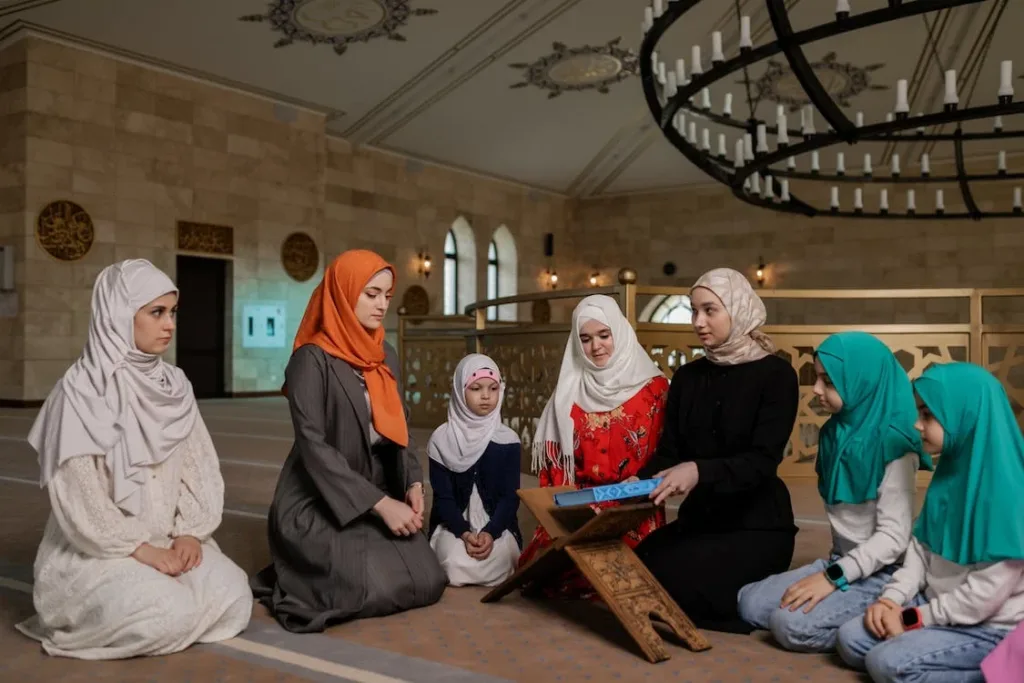As August comes to an end, the French political season springs into action, with government officials unveiling new policies following their summer break. This year, Gabriel Attal, the newly-appointed Minister of Education and a trusted ally of President Emmanuel Macron, made a significant announcement on live television. He declared a ban on the abaya, a traditional long dress worn by Muslim women, in state schools, justifying this move as a defense of secularism.
1.what is Abaya?
2.From Controversy To Court

This latest policy development is rooted in moral panic and systemic Islamophobia. It does not necessitate new legislation; instead, it relies on the existing 2004 law that bans any “religious ostentatious symbol” in state schools, originally intended to target the hijab but now expanded to include the abaya.
To outsiders, this might seem like another instance of Islamophobia in France, but French Muslims are sadly accustomed to such actions. The irrational fear of any manifestation of Muslim identity, especially among children, has become deeply ingrained in French governance and society.
Over the past three decades, French schools have become a battleground for political conflict. The resurgence of Islamic practice and interest in Islamic education within the Muslim community, coupled with the narrative of Islamophobia in the context of the “War on Terror,” has led to harsh Republican repression in France. Muslim children have been singled out as important targets, portrayed as a potential threat to French and Western civilization. Consequently, hijab was banned in state educational institutions. However, this did not deter girls and women from wearing it; they simply removed it once inside, reminiscent of colonial-era “uncoverings.” The persecution of Muslims extended beyond the classroom.

Community activists have documented numerous testimonies of Muslim girls being questioned by school authorities about dresses deemed excessively long. At the interior ministry’s request, state schools in the south of France recorded the identities of Muslim children attending Eid Al-Fitr celebrations. With the implementation of a “systematic obstruction” policy and the adoption of the anti-Separatism Law, Islamic schools have faced closures and harassment by state officials using indirect legal means to target them. Muslim children, like their parents before them, are now perceived as potential security threats, criminalized by a nation historically viewing Muslim identity and empowerment as a catalyst for its own decline.
This approach is not new; it bears resemblance to tactics employed by European colonial authorities. In French-occupied Algeria, the teaching of Islam and the Arabic language were severely restricted. Muslim freedom fighters opposed this policy and founded their liberation struggle on the spread of Islamic knowledge, which became the cornerstone of Muslim political empowerment. Assimilationist education was seen as a path to subservience and political passivity, leading to the prohibition of “public criticism of France and its government” by Muslims. France has always maintained a watchful eye on Muslim empowerment, equating it with a strategic threat.
Today, the education system remains crucial for the survival and success of the French Republic, as it is where the seeds of its long-term goals are sown. For French children, education provides the fertile ground for the cultivation of Republican supremacy. The state aims to establish an education system that quashes the ability of the Muslim community to voice legitimate political dissent rooted in their faith.
1.What is Abaya?
An abaya is a loose-fitting, long, and flowing outer garment worn by some Muslim women as a symbol of modesty and religious adherence. It is typically worn over other clothing and is commonly associated with Islamic culture. The abaya is often black, but it can come in various colors and styles, depending on regional and personal preferences.
The garment covers the entire body, except for the face, hands, and feet. Some abayas have intricate embroidery or embellishments, while others are more simple and plain in design. It is commonly worn in many Muslim-majority countries and communities around the world, and its use may vary based on cultural traditions and individual choices.
2.From Controversy To Court:
In a recent move that has ignited heated debates and stirred discontent within the Muslim community, the French government declared a ban on the abaya in state schools, invoking the principles of secularism deeply ingrained in the nation’s constitutional tradition known as laicite. This decision has rekindled concerns among French Muslims, who perceive it as an attack on their religious freedoms and a continuation of the challenges they face in a society that has become increasingly hostile toward their expressions of faith.
The abaya, a loose-fitting dress worn by women, holds cultural and religious significance primarily within the Muslim world. While historically donned across various cultures and religious backgrounds, in contemporary France, it is predominantly associated with Muslim women. However, only a subset of Muslim women and girls choose to wear the abaya.
France’s staunch commitment to secularism has been cited as the driving force behind the ban. The government argues that allowing young Muslim women to wear the abaya in schools contradicts the principles of laicite, emphasizing the separation of religious influence from the educational sphere. This stance, while ostensibly rooted in secular values, has sparked controversy and criticism on several fronts.
Critics of the ban argue that it disproportionately targets and restricts the religious freedoms of Muslim women, blurring the lines between constitutional demands for secularism and the principles of freedom of expression and religion. Many feminists view the ban as an intrusion into women’s autonomy over their choice of clothing, perpetuated by a male-dominated government.
Some critics have drawn connections between France’s treatment of its Muslim population and its colonial history, particularly in Algeria. This perspective suggests that the government sees French Muslims, many of whom have roots in former colonies, as subjects to be controlled rather than equal citizens. President Emmanuel Macron’s policies toward Muslims, labeled by some as Islamophobic, have intensified these concerns. The controversial ‘anti-separatism’ bill introduced in 2021 further fueled accusations of discriminatory practices against the Muslim community.
The ban has not been met without resistance. Muslim girls have defiantly continued to wear the abaya to school, with hundreds attending classes clad in the garment. Strikes and protests have erupted in response to what some perceive as an “Islamophobic policy” enforced by the government. In a stark illustration of the ban’s counterintuitive nature, one Muslim father was arrested for threatening a school principal after his daughter was denied entry while wearing the abaya.
Amid growing dissent, a group called Action for the Rights of Muslims (ADM) filed an injunction against the ban, arguing that it was discriminatory and could incite hatred against Muslims. However, France’s highest court dismissed the case, prompting other Muslim advocacy groups to consider additional legal action.
This recent ban on the abaya in schools echoes earlier measures enacted in 2004, which targeted “all religious signs” in schools. Though ostensibly inclusive, the legislation was widely perceived as aimed at Muslim female pupils wearing the headscarf, reflecting a historical pattern of targeting Islamic attire. More recently, the ‘anti-separatism’ act introduced a “neutrality principle,” prohibiting female Muslim civil servants from wearing the hijab or other ostensibly religious dress.
As France grapples with the delicate balance between secularism and religious freedom, the abaya ban in schools has intensified existing tensions, leaving many within the Muslim community feeling alienated and discriminated against. The controversy surrounding this ban underscores the complex challenges of fostering a harmonious coexistence of diverse religious and cultural practices within the French societal framework.
France’s highest administrative court has upheld the government’s prohibition on the wearing of traditional abayas, long and loose garments worn by some Muslim women, in public schools. Dismissing claims that the ban is discriminatory and could incite hatred, the State Council announced its rejection of a request for an injunction against the ban. Prior to the ruling, France’s Council of the Muslim Faith expressed concerns about an increased risk of discrimination and contemplated filing its own court complaint.
French President Emmanuel Macron’s administration had recently imposed a ban on both abayas and qamis (a long, loose-fitting garment worn by some Muslim men) in schools, citing violations of secularism in education. The ban on Muslim headscarves was already in place, justifying it as a measure against displaying religious affiliation.
Action for the Rights of Muslims (ADM), an association representing Muslims, filed a motion with the State Council seeking an injunction against the ban, asserting that it was discriminatory and had the potential to incite hatred against Muslims. However, the State Council, after examining the motion, rejected the argument, stating that wearing these garments “follows the logic of religious affirmation” and aligns with French law prohibiting visible signs of any religious affiliation in schools.
The Council emphasized that the government’s ban did not cause significant harm to personal lives, freedom of religion, the right to education, the wellbeing of children, or the principle of non-discrimination. ADM’s lawyer, Vincent Brengarth, argued during the hearing that the abaya should be considered a traditional garment rather than a religious one. He also accused the French government of pursuing political advantage through the ban.
Despite the court’s decision, approximately 300 schoolgirls defied the ban on the first day of the French school year, refusing to remove their abayas. While most eventually agreed to change garments, 67 remained steadfast and were sent home, according to Education Minister Gabriel Attal. A protest group at Maurice Utrillo High School in Stains, Seine-Saint-Denis, northeast of Paris, issued a statement distancing themselves from what they deemed the government’s Islamophobic policy, emphasizing the need to welcome students without policing their clothing choices.
It is noteworthy that in 2016, the State Council overturned a ban on the “burkini” in a French Riviera resort, asserting that there was no perceived threat to public order from the long bathing suit worn by some Muslim women.
The Abaya: A Symbol of Modesty, Faith, and Cultural Identity
The abaya, a flowing cloak-like garment, holds immense significance for Muslim women across the globe. Beyond being mere attire, it carries profound cultural, religious, and social meanings. Let’s explore why the abaya is so important in Islam:
Religious and Cultural Significance
- Modesty and Adherence to Islamic Values: The abaya embodies the commitment to modesty advocated by Islamic teachings. It envelops the body from neck to ankles, emphasizing the importance of covering one’s physical form. Accompanied by a headscarf (hijab) that covers the hair, the abaya symbolizes adherence to religious values and connects women to their faith and heritage.
- Diverse Styles and Regional Variations: The abaya comes in diverse styles, colors, and designs across various regions and cultures. In Gulf nations, abayas feature intricate embroidery, embellishments, and even Swarovski crystals, reflecting the opulence of the region.
Fashion and Modernization
- Dynamic Transformation: While deeply rooted in tradition, the abaya has evolved over time. Fashion designers have ingeniously merged traditional elements with contemporary aesthetics. Modern abayas now span a wide array of styles, cuts, and materials, appealing to a new generation.
- Identity and Artistic Innovation: The abaya serves a dual role: as an identity symbol and a canvas for artistic expression. It blends cultural heritage with modern fashion, breathing fresh vitality into this timeless garment.
Challenges and Empowerment
- Controversy and Choice: Some argue that the abaya perpetuates stereotypes or restricts women’s freedom. However, many women choose to wear it willingly, finding empowerment in upholding cultural and religious values while expressing their individuality.
Where to Buy Abayas
- Local Markets and Specialty Stores: In regions with substantial Muslim populations, local markets and specialty stores offer a diverse array of abayas catering to various tastes and preferences.
- Online Platforms: The proliferation of online platforms allows shoppers to explore designs from around the world and directly engage with designers and artisans.
In summary, the abaya remains a powerful symbol—a fusion of tradition, faith, and artistic innovation. It reflects both modesty and individuality, making it an integral part of Muslim women’s lives.
To Know about Abaya on Please Click Here
You May like:


